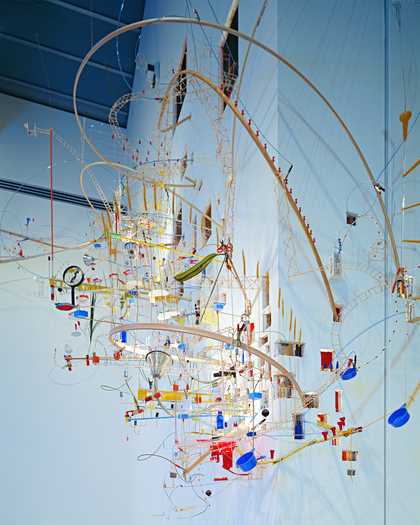Seamless connects familiar objects from everyday life into a three-dimensional network
Sze incorporates objects designed for human scale, such as tools for installing sculpture such as a ladder and a spirit level. Other components, like the tiny wooden bridges, could imply a miniature scale. The sculpture sweeps across the space in delicate curves, connecting the objects into a single larger construction. The spiralling structures suggest the double helix shape of DNA – molecules that determine the growth and reproduction of all living things.
Although titled Seamless, the work draws attention to the ‘seams’ of the museum’s architecture. Several rectangles are cut into the walls where the sculpture penetrates. They reveal the construction of the museum building and the functional spaces behind its pristine ‘white cube’ galleries.
Seamless also refers to art historical sources from the early 20th century. Its structures and shapes relate to constructivism (abstract art that reflected the modern industrial world). Sze’s use of the colours red, blue and yellow recalls the Dutch modernist art movement De Stijl. This promoted ‘pure’ abstraction using only straight lines and primary colours.
Seamless is displayed together with Judith Rothschild's Untitled Composition, a painting also inspired by De Stijl’s use of simplified lines and primary colours. Rothschild was especially influenced by the grid-like abstract works of Piet Mondrian. However, the lines in her painting includes many irregular shapes and organic curves. They are based on objects depicted in the genre of still life, simplified to the point of no longer being recognisable. Her compositions are the result of a process of abstraction from real things.
Tate Modern
Natalie Bell Building Level 4 West
Room 11
1 February 2022 – 1 December 2024

